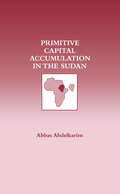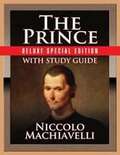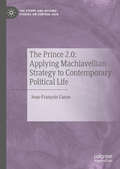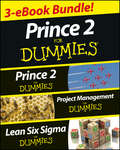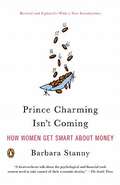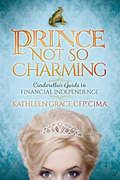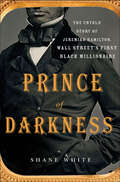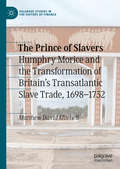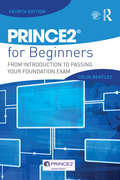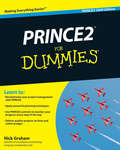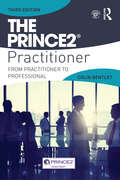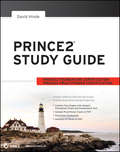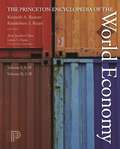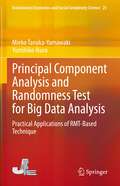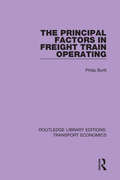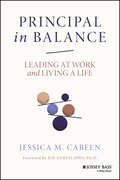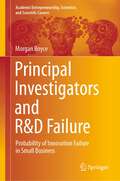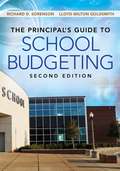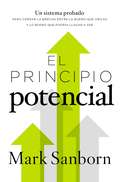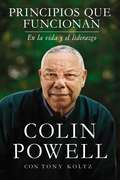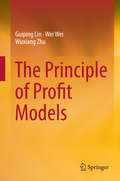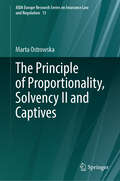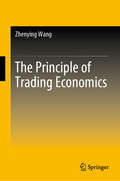- Table View
- List View
Primitive Capital Accumulation in the Sudan
by Abbas AbdelkarimThis title available in eBook format. Click here for more information.Visit our eBookstore at: www.ebookstore.tandf.co.uk.
The Prince: The Prince; Power; The Art Of War
by Niccolò MachiavelliThe world&’s most influential—and controversial—treatise on politicsComposed in exile and published posthumously, The Prince is Niccolò Machiavelli&’s legacy and the foundation of modern political theory. Drawing on his firsthand experiences as a diplomat and military commander in the Florentine Republic, Machiavelli disregards the rhetorical flourishes and sentimentality typically found in sixteenth-century mirrors for princes—guides instructing noblemen in the fine art of ruling—and gets straight to practical matters: how to eliminate rivals, when to use force, whether it is better to be loved or feared. For its cold-blooded candor and unrepentant assertion that immorality can be a political virtue, The Prince was censured and Machiavelli&’s name became synonymous with evil. Yet five centuries&’ worth of political thinkers and leaders, from Thomas Cromwell to Francis Bacon to Napoleon Bonaparte to John Adams to Joseph Stalin, have turned to this slim volume for guidance and inspiration, because its advice on the acquisition and preservation of power contains the wisdom of experience—and, most importantly of all, because it works. This ebook has been professionally proofread to ensure accuracy and readability on all devices.
The Prince: With Study Guide
by Niccolo Machiavelli Theresa PuskarThroughout his lifetime and in the years that followed Niccolo Machiavelli was best known for his strategic thinking in the world of politics and power. His writings have remained timely and highly controversial. This deluxe edition of this classic work, includes a 21st century study guide filled with practices and exercises that will provide a summary and insights on Machiavelli's teachings and provide you with the fundamental traits that help to cultivate a successful leader.
The Prince 2.0: Applying Machiavellian Strategy to Contemporary Political Life (The Steppe and Beyond: Studies on Central Asia)
by Jean-François CaronThis Pivot updates the ideas of the famous political philosopher from the Italian Renaissance, Machiavelli, for the 21st century, using case studies from the West and from Kazakhstan to demonstrate the utility of Machiavelli's ideas for contemporary political life. In truth, Machiavelli's ideas have never lost their value. Although "Machiavellian" as an adjective tends to describe amoral cynicism in contemporary usage, Machiavelli's ideas were deeply ethical and oriented towards achieving long-term goals. Contemporary readers may be put off by medieval language and examples, misled into believing Machiavelli speaks to a different age; and yet the author here explores how Machiavellian strategy can be of value— ethical as well as practical—in the 21st century.
PRINCE 2 For Dummies Three e-book Bundle: Prince 2 For Dummies, Project Management For Dummies & Lean Six Sigma For Dummies
by Nick Graham John Morgan Martin Brenig-JonesPacked with expert advice, this e-book bundle steers you through every step in the PRINCE2 and project management process - from initial planning to risk management and quality control. It also covers the techniques of Lean Six Sigma that will help you achieve your business goals by improving both the quality and efficiency of your projects. PRINCE2 For Dummies is the perfect guide to using this project management method to help ensure its success. It takes you through every step of a project - from planning and establishing roles to closing and reviewing - offering practical and easy-to-understand advice on using PRINCE2. Project Management For Dummies shows business professionals what works and what doesn’t by examining the field’s best practices. Readers will learn how to organise, estimate and schedule projects more efficiently. Lean Six Sigma For Dummies outlines the key concepts of this strategy in plain English and explains how you can use it to get the very best out of your business. Combining the leading improvement methods of Six Sigma and Lean, this winning technique drives performance to the next level.
Prince Charming Isn't Coming
by Barbara StannyNow updated?the classic guide that teaches women how to take control of their own finances When this groundbreaking yet compassionate book was first published ten years ago, it lifted a veil on women?s resistance to managing their money, revealing that many were still waiting for a prince to rescue them financially. In this revised edition, which reflects our present-day economic world, Barbara Stanny inspires readers to take charge of their money and their lives. Filled with real-life success stories and practical advice?from tips on identifying the factors that keep women fearful and dependent to checklists and steps for overcoming them?this book is the next best thing to having one?s own financial coach. .
Prince Not So Charming: Cinderella's Guide to Financial Independence (Prince Not So Charming Ser.)
by Kathleen GraceA certified financial planner narrates a woman&’s journey to financial independence, providing money management tips for single, married or divorced women. In Prince Not So Charming, you will take a riveting journey with Cinderella as she navigates romance, emotional upheaval, and near-financial-death experiences—all of which lead her to find inner strength despite seemingly insurmountable setbacks. Nine out of ten women will be solely responsible for their finances at some point in their lives. Prince Not So Charming is a call to action that will inspire and empower you to take control of your finances regardless of the obstacles you face, plus you&’ll learn: · Strategies for women to regain power and avoid financial ruin · How to maintain financial independence—whether you're married, single, or contemplating divorce—and why this is so important · Financial strategies to help you safeguard yourself and those you love · Ideas to reduce the financial and emotional burdens of divorce Whether you're a high-powered executive or a single mom struggling to make ends meet, Prince Not So Charming will encourage you to claim your power to create and protect your financial future.
Prince of Darkness: The Untold Story of Jeremiah Hamilton, Wall Street's First Black Millionaire
by Shane White&“A well-told, stereotype-busting tale about a nineteenth century black financier who dared to be larger than life, and got away with it!&” —Elizabeth Dowling Taylor, New York Times–bestselling author In the middle decades of the nineteenth century Jeremiah G. Hamilton was a well-known figure on Wall Street. Cornelius Vanderbilt, America&’s first tycoon, came to respect, grudgingly, his one-time opponent. Their rivalry even made it into Vanderbilt&’s obituary. What Vanderbilt&’s obituary failed to mention, perhaps as contemporaries already knew it well, was that Hamilton was African American. Hamilton, although his origins were lowly, possibly slave, was reportedly the richest black man in the United States, possessing a fortune of $2 million, or in excess of two hundred and $50 million in today&’s currency. In Prince of Darkness, a groundbreaking and vivid account, eminent historian Shane White reveals the larger than life story of a man who defied every convention of his time. He wheeled and dealed in the lily-white business world, he married a white woman, he bought a mansion in rural New Jersey, he owned railroad stock on trains he was not legally allowed to ride, and generally set his white contemporaries teeth on edge when he wasn&’t just plain outsmarting them. An important contribution to American history, Hamilton&’s life offers a way into considering, from the unusual perspective of a black man, subjects that are usually seen as being quintessentially white, totally segregated from the African American past.&“If this Hamilton were around today, he might have his own reality TV show or be a candidate for president . . . An interesting look at old New York, race relations, and high finance.&” —New York Post
The Prince of Slavers: Humphry Morice and the Transformation of Britain's Transatlantic Slave Trade, 1698–1732 (Palgrave Studies in the History of Finance)
by Matthew David MitchellMuch scholarship on the British transatlantic slave trade has focused on its peak period in the late eighteenth century and its abolition in the early nineteenth; or on the Royal African Company (RAC), which in 1698 lost the monopoly it had previously enjoyed over the trade. During the early eighteenth-century transition between these two better-studied periods, Humphry Morice was by far the most prolific of the British slave traders. He bears the guilt for trafficking over 25,000 enslaved Africans, and his voluminous surviving papers offer intriguing insights into how he did it. Morice’s strategy was well adapted for managing the special risks of the trade, and for duplicating, at lower cost, the RAC’s capabilities for gathering information on what African slave-sellers wanted in exchange. Still, Morice’s transatlantic operations were expensive enough to drive him to a series of increasingly dubious financial manoeuvres throughout the 1720s, and eventually to large-scale fraud in 1731 from the Bank of England, of which he was a longtime director. He died later that year, probably by suicide, and with his estate hopelessly indebted to the Bank, his family, and his ship captains. Nonetheless, his astonishing rise and fall marked a turning point in the development of the brutal transatlantic trade in enslaved Africans.
PRINCE2 For Beginners: From Introduction To Passing Your Foundation Exam
by Colin BentleyThinking about using PRINCE2 to manage your projects or preparing for PRINCE2 training? Need a rounded introduction to help you get to grips with the basics? PRINCE2 For Beginners: from introduction to passing your Foundation exam is the perfect start. This readable end-to-end explanation is simple enough to introduce you to the basics, yet includes everything you need to know to get through the foundation exam. This new concise edition starts from a more accessible level than other detailed manuals or brief refreshers and will help ease you into the topic and put the method into a real-world context. This new concise edition now includes more support for the Foundation exam, including a student guide to the exam itself, sample answers and explanations. Whether you are looking for a reliable introduction or a quick reference to prepare you for PRINCE2 training and study, PRINCE2 For Beginners will give you the grounding to take your knowledge and application to the next level.
PRINCE2 For Dummies, 2nd Edition
by Nick GrahamWhatever your project - no matter how big or small - PRINCE2 For Dummies, 2009 Edition is the perfect guide to using this project management method to help ensure its success. Fully updated with the 2009 practice guidelines, this book will take you through every step of a project - from planning and establishing roles to closing and reviewing - offering practical and easy-to-understand advice on using PRINCE2. It also shows how to use the method when approaching the key concerns of project management, including setting up effective controls, managing project risk, managing quality and controlling change. PRINCE2 allows you to divide your project into manageable chunks, so you can make realistic plans and know when resources will be needed. PRINCE2 For Dummies, 2009 Edition provides you with a comprehensive guide to its systems, procedures and language so you can run efficient and successful projects. PRINCE2 For Dummies, 2009 Edition includes: Part I: How PRINCE Can Help You- Chapter 1: So What's a Project Method and Why Do I Need to Use One? - Chapter 2: Outlining the Structure of PRINCE2 - Chapter 3: Getting Real Power from PRINCE2 Part II: Working Through Your Project- Chapter 4: Checking the Idea Before You Start - Chapter 5: Planning the Whole Project: Initiation - Chapter 6: Preparing for a Stage in the Project - Chapter 7: Controlling a Stage - Chapter 8: Building the Deliverables - the Work of the Teams - Chapter 9: Finishing the Project - Chapter 10: Running Effective Project Boards Part III: Help with PRINCE Project Management - Chapter 11: Producing and Updating the Business Case - Chapter 12: Deciding Roles and Responsibilities - Chapter 13: Managing Project Quality - Chapter 14: Planning the Project, Stages, and Work Packages - Chapter 15: Managing Project Risk - Chapter 16: Controlling Change and Controlling Versions - Chapter 17: Monitoring Progress and Setting Up Effective Controls Part IV: The Part of Tens- Chapter 18: Ten Ways to Make PRINCE Work Well - Chapter 19: Ten Tips for a Good Business Case - Chapter 20: Ten Things for Successful Project AssurancePart V: Appendices- Appendix A: Looking into PRINCE Qualifications - Appendix B: Glossary of the Main PRINCE2 Terms
The PRINCE2 Practitioner: From Practitioner to Professional
by Colin BentleyStruggling to apply the principles of PRINCE2 in practice? Need guidance on adapting the process for smaller projects? PRINCE2 for Practitioners provides the solution. This practical reference, matching the details and requirements of the 2009 PRINCE2 manual, contains new and updated real-life examples and case studies, links between related components and processes, and clear guidance on how to fine-tune the method to help you manage projects successfully, whatever the context and size. An affordable alternative to expensive training, this best-selling handbook by PRINCE2 expert Colin Bentley is an indispensable addition to your project management bookshelf and a companion to the PRINCE2 for Beginners book. If you have passed the PRINCE2 exams, it will help you keep your knowledge and skills up to date to maintain registered status and enable you to apply the theory of PRINCE2 to everyday project work after certification.
PRINCE2 Study Guide
by David HindeEverything you need to be fully prepared to take the PRINCE2 Foundation and Practitioner examAs an internationally recognized certification which focuses on the Foundation and Practitioner levels along with being recommended by the Project Management Institute, the PRINCE2 accreditation gives a bolster to any resume.The author, David Hinde, has trained hundreds of individuals from many different backgrounds to prepare for the PRINCE2 exams. The book provides explanations of all parts of the PRINCE2 approach, lots of practical examples, and a whole range of mock examination questions to test your knowledge.Explains all the PRINCE2 themes, processes, principles, roles and management products for the very latest version of PRINCE2 (PRINCE2 2009 Edition)Features full coverage of all Foundation and Practitioner level exam objectivesPresents real-world scenarios, showing how the method is used in business and the public sectorIncludes challenging review questions and electronic flashcards to sharpen your knowledgeCovers tips and techniques for tackling the PRINCE2 accreditation examinations and shows you how and where to take the examsIncorporates over 300 sample Foundation-level and over 100 sample Practitioner-level questions, with answers and full explanationsContains a glossary of all PRINCE2 terminology and a quick reference to all the PRINCE2 management productsGives a web link to a set of on-line tools with more bonus examsPRINCE2 Study Guide covers all the necessary topics you need to know in order to confidently take the PRINCE2 Foundation and Practitioner exams.
Princes, Brokers, and Bureaucrats: Oil and the State in Saudi Arabia
by Steffen HertogIn Princes, Brokers, and Bureaucrats, the most thorough treatment of the political economy of Saudi Arabia to date, Steffen Hertog uncovers an untold history of how the elite rivalries and whims of half a century ago have shaped today's Saudi state and are reflected in its policies. Starting in the late 1990s, Saudi Arabia embarked on an ambitious reform campaign to remedy its long-term economic stagnation. The results have been puzzling for both area specialists and political economists: Saudi institutions have not failed across the board, as theorists of the "rentier state" would predict, nor have they achieved the all-encompassing modernization the regime has touted. Instead, the kingdom has witnessed a bewildering mélange of thorough failures and surprising successes.Hertog argues that it is traits peculiar to the Saudi state that make sense of its uneven capacities. Oil rents since World War II have shaped Saudi state institutions in ways that are far from uniform. Oil money has given regime elites unusual leeway for various institutional experiments in different parts of the state: in some cases creating massive rent-seeking networks deeply interwoven with local society; in others large but passive bureaucracies; in yet others insulated islands of remarkable efficiency. This process has fragmented the Saudi state into an uncoordinated set of vertically divided fiefdoms. Case studies of foreign investment reform, labor market nationalization and WTO accession reveal how this oil-funded apparatus enables swift and successful policy-making in some policy areas, but produces coordination and regulation failures in others.
The Princeton Encyclopedia of the World Economy. (Two volume set)
by Kenneth A. Reinert Ramkishen S. RajanAn essential reference to all facets of the world economyIncreasing economic globalization has made understanding the world economy more important than ever. From trade agreements to offshore outsourcing to foreign aid, this two-volume encyclopedia explains the key elements of the world economy and provides a first step to further research for students and scholars in public policy, international studies, business, and the broader social sciences, as well as for economic policy professionals.Written by an international team of contributors, this comprehensive reference includes more than 300 up-to-date entries covering a wide range of topics in international trade, finance, production, and economic development. These topics include concepts and principles, models and theory, institutions and agreements, policies and instruments, analysis and tools, and sectors and special issues. Each entry includes cross-references and a list of sources for further reading and research. Complete with an index and a table of contents that groups entries by topic, The Princeton Encyclopedia of the World Economy is an essential resource for anyone who needs to better understand the global economy.More than 300 alphabetically arranged articles on topics in international trade, finance, production, and economic developmentInternational team of contributorsAnnotated list of further reading with each articleTopical list of entriesFull index and cross-references Entry categories and sample topics:Concepts and principles: globalization, anti-globalization, fair trade, foreign direct investment, international migration, economic development, multinational enterprisesModels and theory: Heckscher-Ohlin model, internalization theory, New Trade Theory, North-South trade, Triffin dilemmaInstitutions and agreements: European Union, International Monetary Fund, World Trade Organization, World Bank, Doha Round, international investment agreementsPolicies and instruments: dollar standard, international aid, sanctions, tariffsAnalysis and tools: exchange rate forecasting, effective protection, monetary policy rulesSectors and special issues: child labor, corporate governance, the digital divide, health and globalization, illegal drugs trade, petroleum, steel
Principal Component Analysis and Randomness Test for Big Data Analysis: Practical Applications of RMT-Based Technique (Evolutionary Economics and Social Complexity Science #25)
by Mieko Tanaka-Yamawaki Yumihiko IkuraThis book presents the novel approach of analyzing large-sized rectangular-shaped numerical data (so-called big data). The essence of this approach is to grasp the "meaning" of the data instantly, without getting into the details of individual data. Unlike conventional approaches of principal component analysis, randomness tests, and visualization methods, the authors' approach has the benefits of universality and simplicity of data analysis, regardless of data types, structures, or specific field of science. First, mathematical preparation is described. The RMT-PCA and the RMT-test utilize the cross-correlation matrix of time series, C = XXT, where X represents a rectangular matrix of N rows and L columns and XT represents the transverse matrix of X. Because C is symmetric, namely, C = CT, it can be converted to a diagonal matrix of eigenvalues by a similarity transformation SCS-1 = SCST using an orthogonal matrix S. When N is significantly large, the histogram of the eigenvalue distribution can be compared to the theoretical formula derived in the context of the random matrix theory (RMT, in abbreviation). Then the RMT-PCA applied to high-frequency stock prices in Japanese and American markets is dealt with. This approach proves its effectiveness in extracting "trendy" business sectors of the financial market over the prescribed time scale. In this case, X consists of N stock- prices of length L, and the correlation matrix C is an N by N square matrix, whose element at the i-th row and j-th column is the inner product of the price time series of the length L of the i-th stock and the j-th stock of the equal length L. Next, the RMT-test is applied to measure randomness of various random number generators, including algorithmically generated random numbers and physically generated random numbers. The book concludes by demonstrating two applications of the RMT-test: (1) a comparison of hash functions, and (2) stock prediction by means of randomness, including a new index of off-randomness related to market decline.
The Principal Factors in Freight Train Operating (Routledge Library Editions: Transport Economics #17)
by Philip BurttThis book, first published in 1923, examines the states of Britain’s rail network at the cusp of great change. The Railways Act of 1921 placed public service on behalf of the community as the raison d’etre of a railway company’s existence – rather than the private gain of shareholders.
Principal in Balance: Leading at Work and Living a Life
by Jessica M. CabeenA must-have guide to succeeding at school leadership without sacrificing personal balance Reports of burnout, stress, and compassion fatigue are on the rise. These issues push many out of the profession, leading to high turnover and sub-optimal student outcomes. How can school leaders combat these problems? Leaders can manager their own wellness and priorities. Healthy leaders who learn balance can create motivation, confidence, quality collaboration, and enthusiasm among staff and other stakeholders. Principal in Balance offers principals strategies and tools to take more ownership of their lives at work and home, so everyone in the K–12 educational community can thrive. Nationally Distinguished Principal and four-time author Jessica Cabeen shows you how to navigate leading at work and having a fulfilling life. Throughout the book, you gain actionable points to help you set achievable goals, find time in the day to accomplish them, and have time to enjoy rest at home. You’ll learn to better meet the needs of your administration, staff, parents, and students using intentional and creative actions without sacrificing yourself. Learn to balance work and life to create higher productivity Gain proven tips for successful goal setting, staff retention, and student learning Discover lead-to-win strategies that can help you improve your leadership in all areas Make intentional space in your daily life for self-care and permission to restPrincipal in Balance offers a practical, timely approach by a school leader for school leaders to cultivate work/life balance. This book is an essential companion for K–12 school leaders and administrators, aspiring school leaders, and teacher trainers.
Principal Investigators and R&D Failure: Probability of Innovation Failure in Small Business (Academic Entrepreneurship, Scientists, and Scientific Careers)
by Morgan BoyceFailure in R&D efforts are fairly common and with many factors that contribute to the outcome. This book focuses on the role of principal investigators (PIs) in R&D project failures and provides a theoretical model explaining how firm characteristics, including those of the PIs, impact the probability of failure. The theoretical model also serves as a structural form model to motivate the empirical analysis which assesses the probability of failure in small technology-based firms. The author uses data from the U.S. Department of Energy’s (DOE) Small Business Innovation Research (SBIR) program to build a new and informative tool to assess R&D projects and demonstrate the strengths of the theoretical model. The association between PIs and R&D failure not only provides insights that can have a downstream impact to economic growth, but it can also provide policymakers with valuable information to aid decisions in allocating funds for R&D.
The Principal's Guide To School Budgeting
by Richard D. Sorenson Lloyd Milton GoldsmithLearn how to create a winning school budget during challenging economic times. Effective administrative practices, both fiscal and academic, are continually being redefined at all levels. Developing budgets that keep up with economic changes and instructional expectations is a challenge. This best-seller puts leaders through the budgeting process, with vision and planning as firm guides to resource allocation. Emphasizing tough budgetary climates, the book includes a budget model that shows how to align organizational goals with a sound fiscal accountability system.
El principio potencial: Un sistema probado para cerrar la brecha entre lo bueno que eres y lo bueno que pudieras ser
by Mark SanbornEn este momento, sabes cuán bueno eres. Pero ¿sabes qué tan Bueno podrías llegar a ser?Parece tener sentido común: convertirte en el mejor en lo que haces, y luego seguir ese camino en automático. ¿Correcto?No. Cuando llegas a la cima, es el momento de pisar el acelerador porque apenas estás comenzando.MDMEl autor best seller del New York Times y experto en liderazgo Mark Sanborn demuestra que no importa lo que hayas hecho hasta ahora, puedes llegar a ser aún mejor. En El principio potencial, Sanborn enseña cómo lograrlo al proporcionarte pasos prácticos y explica en dónde enfocar tus esfuerzos.Alcanzar tu potencial es el resultado de utilizar consistentemente un pequeño conjunto de herramientas fáciles de recordar en las siguientes áreas: interrupción, (re)enfoque, compromise y expansión. El principio potencial revela el secreto para alcanzar un avance sin precedentes en cualquier área de tu vida. Aplica la fórmula de Sanborn en tu trabajo y en tu vida familiar para lograr un mayor éxito en las áreas que te importan. Verás que tu mejor puede ser aún mejor. Y llegar a ser aún mejor siempre le gana a ser simplemente el mejor.Mark Sanborn, experto en liderazgo y autor best seller internacional de El Factor Fred, te invita a superarte y a cerrar la brecha entre lo bueno que eres y lo bueno que pudieras llegar a ser.El principio potencial muestra cómo emplear el exclusivo diseño de Sanborn llamado «Matriz potencial» a áreas específicas de tu vida y proporciona las herramientas que necesitas para ver un progreso significativo.Una de las oportunidades más emocionantes está cada día frente a ti: persiguiendo tu verdadero potencial. Estás en el camino. Puedes hacer que tu mejor esfuerzo pase a segundo lugar. Puedes sobrepasarlo.
Principios que funcionan: En la vida y el liderazgo
by Colin PowellEste libro es una colección de lecciones y anécdotas personales que han formado la carrera en el servicio público del general de cuatro estrellas y anterior Secretario de Estado Colin Powell. En el corazón de este libro se encuentran las «13 reglas», notas que él ha acumulado en su escritorio, y ahora son base de sus presentaciones de liderazgo en todo el mundo. Las reglas cortas y sencillas de Powell como «enójate y luego supéralo» y «comparte crédito» salen a la luz al revelar historias personales que presentan y amplían sus principios para el liderazgo efectivo: convicción, trabajo duro, y sobre todo, respeto por otros. En el trabajo y en la vida, Powell escribe «es el gesto humano lo que cuenta». Una convincente narrador, Powell comparte las parábolas tanto humorísticas como solemnes que ofrecen sabios consejos sobre cómo triunfar en el lugar de trabajo y más allá. «Confía en tu gente», aconseja mientras delega pequeñas responsabilidades presidenciales a dos ayudantes principiantes. «Haz lo mejor alguien está viendo», les aconseja a aquellos que recién están comenzando, al recordar su propio trabajo de verano cuando era adolescente enviando cajas de soda. Powell combina el conocimiento que ha ganado al servir en los altos rangos de la milicia y en cuatro administraciones presidenciales, así como también las lecciones aprendidas de una crianza difícil en el Bronx y su entrenamiento en ROTC. El resultado es un retrato poderoso de un líder que es prudente, modesto y agradecido por las contribuciones de cada una de las personas con las que trabaja. Este libro de Colin Powell está hecho para inspirar, conmover y sorprender a los lectores. Profundo y revelador, es un brillante y original modelo de liderazgo.
The Principle of Profit Models
by Guiping Lin Wei Wei Wuxiang ZhuThis book mainly focuses on defining profit models, on how many main kinds of profit models there are, how profit models can change a company, and how to tailor a profit model to the needs of a certain company. In this context, profit models are classified as fixed-income, remaining-profit and profit-sharing, admission, toll, parking, fuel and sharing fees, profit sources, customer pricing, auction, combined pricing, etc. The logic behind all these profit models will be analyzed in detail and numerous micro-cases will be introduced. All of the micro-cases discussed are the best profit model practices used by outstanding enterprises, mainly from China and the USA (including HomeAway, Priceline, Tencent, Sina, Google, the Voice of China, CSPN and so on). These models will be complemented by a wealth of figures and additional tools to help readers better understand the principle of profit models. As such, the book not only explains "why" entrepreneurs preferred to apply a specific kind of profit model and not others, but also answers "how" they derived that model.
The Principle of Proportionality, Solvency II and Captives (AIDA Europe Research Series on Insurance Law and Regulation #13)
by Marta OstrowskaThis book offers an in-depth analysis of the principle of proportionality in the EU insurance regulatory regime. It takes a critical look at how proportionality has been implemented in Solvency II and tests its effectiveness on captive (re)insurance undertakings. Given their unique business model, captives are considered the primary beneficiary of proportionality and therefore offer the perfect ‘litmus test’ for the principle’s effectiveness. In a world characterized by overregulation and increasingly complex financial markets, governments and policymakers face the challenge of regulating markets without hindering their growth. As ‘one-size-fits-all’ approaches have long-since been recognized as detrimental, the EU is seeking to develop a regulatory technique which allows more individual regulatory treatment while ensuring a level playing field. The first revolutionary step towards this goal was taken in Solvency II (Directive 2009/138/EC), which introduced a principle of proportionality to the EU insurance market. The principle is a unique tool which makes it possible to adjust the requirements of the Solvency II framework to the nature, scale, and complexity of each individual insurance undertaking’s risk profile. It is intended to help remove an unnecessary regulatory burden for insurance undertakings, and to prevent the proliferation of regulations in general. However, the practical implementation of proportionality is not without its share of obstacles. The principle’s generic nature and the lack of guidance have caused a great deal of confusion regarding its practical application and prevented insurance undertakings from using its benefits to the fullest. Consequently, the principle of proportionality has been subject to revision within the first Solvency II review process. The book will benefit captive owners, captive managers, regulators, supervisors, practitioners, academics, students and, more generally, all those involved with or interested in the insurance market.
The Principle of Trading Economics
by Zhenying WangThis book is devoted to establishing a completely new concept within economics referred to as "trading economics" which is a reconstructed economic system in theory that seeks perfect harmony between micro and macro elements in a structured way, hence making the economic theory a rigorous system supported by internal logical continuity. Representing a revolution of the existing theoretical framework, trading economics has changed the logic of mainstream economics. Specifically, it deduces the "macro whole" from the "micro individuals", and it introduces a systematic and comprehensive analysis approach. It stresses that within an interconnected world, the interaction between trading agents is the fundamental driving force behind the operation, development and evolution of the economic system.
